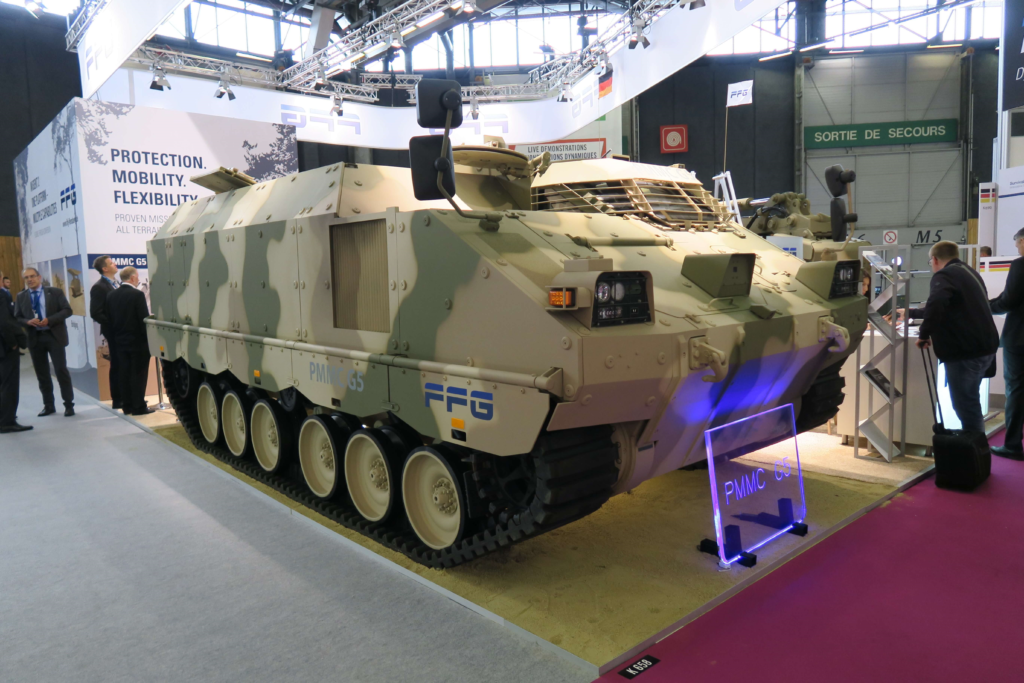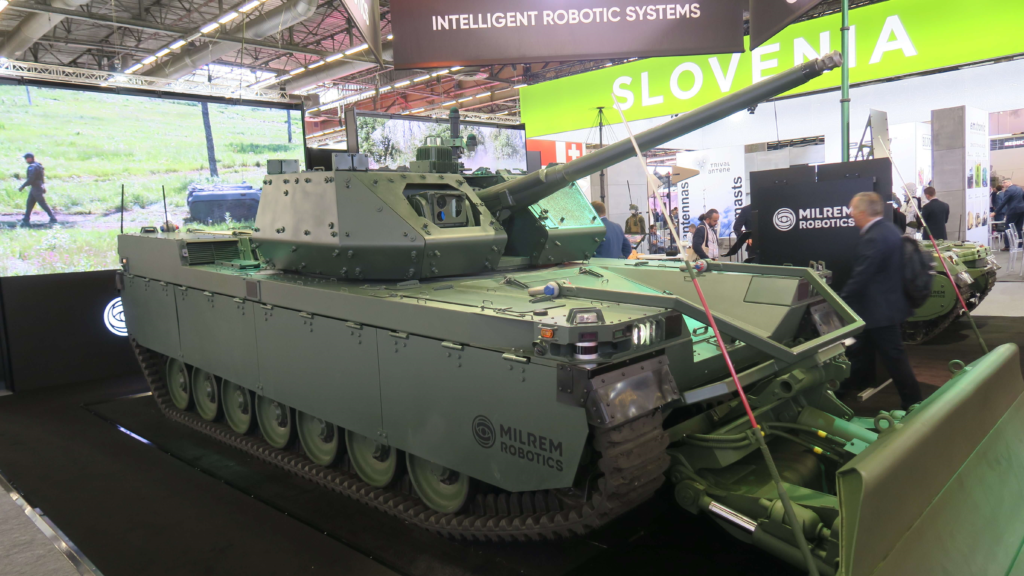Article by Marco Giulio Barone – Military Technology
The debate between tracks and wheels is never-ending, but new models of tracked vehicles start re-populating the market. Rubber tracks are playing a central role in the rediscovery of tracked vehicles.
Historic drivers
In the last decade, land forces who could not afford mixed fleets of tracked and wheeled platforms have been faced with a choice, and the big winner seems to be the wheeled Armoured Fighting Vehicle (AFV). Operationally, wheeled armoured vehicles make it possible to quickly reach the assigned position or to patrol large portions of territory. Wheeled vehicles are less fuel-hungry than tracked ones and can cover larger distances using the normal road network. In addition, more powerful engines, run-flat tires, new transmission systems, and other innovations have closed the tactical mobility gap between tracks and wheels.
However, modern wheeled Infantry Fighting Vehicles (IFV’s) or Armoured Personnel Carriers (APC’s) can suffer from payload capacity, tracked vehicles can typically carry more weight than wheeled vehicles because their weight is distributed more evenly over a larger surface area. As wheeled vehicles keep gaining weight due to new equipment, large calibre weapons, and add-on armours, the differences in the logistic footprint of wheeled vehicles compared to tracked units become smaller and the benefits of tracked vehicles in the tactical environment prove to have greater advantages, namely better off-road performance, improved mobility, and increased survivability.
In fact, tracked vehicles are typically better at navigating difficult terrains, such as mud, snow, or rocky surfaces, because they distribute weight more evenly over a larger surface area. This gives them better traction and stability and allows them to climb over obstacles that wheeled vehicles might get stuck on.
Furthermore, tracked vehicles are generally more manoeuvrable than wheeled vehicles, especially in tight spaces or urban environments where there may be obstacles to navigate around.
Lastly, survivability: tracked vehicles are often considered to be more survivable in combat situations, because they are less likely to be immobilized by enemy fire, and their tracks can continue to function even if one or more wheels are damaged.
Nevertheless, there are also some drawbacks to tracked vehicles, including higher maintenance costs, slower speeds on paved roads, and a tendency to damage roads and other infrastructure. Wheeled vehicles may be a better choice in some situations, such as when speed and manoeuvrability are more important than off-road performance or survivability. Ultimately, the choice between tracked and wheeled armoured vehicles will depend on the specific requirements of the mission and the terrain in which it will be carried out.
With these points in mind, there have been advances in track technology, in rubber tracks and related technologies, which allowed for the replacement of steel tracks, reducing weight and tiresome routine maintenance.
Rubber tracks have reached a high level of maturity, evidenced by the successes of Soucy for the upgrades of the CV-90 fleet. Norway also chose Soucy for its rubber-tracked Armoured Combat Support Vehicle (ACSV) based on FFG’s PMMC G5.
In Australia, within the Land 400 tender evaluation, Hanwha completed competition trials using Soucy’s Composite Rubber Track (CRT) on the AS21 Redback, and whilst Rheinmetall competed primarily with steel track, they demonstrated a Soucy option on the Lynx KF41 IFV.

These examples are just the symptoms of a general tendency that will see the market for rubber tracks doubling in a decade, from today’s €140-160 million to €300-350 million in the 2030s, according to available esteems.
While some operational requirements will remain unchanged for a long time, other completely new ones are rising, such as the growing role of UGVs and the return of a classic understanding of land operations influenced by observations from the war in Ukraine. For example, Milrem Robotics uses Soucy’s CRT system for both its Themis UGV and Type-X unmanned IFV prototypes. Themis is among the few military vehicles of its kind to be deployed by the Ukrainian army – in MEDEVAC roles.

Already, several countries, including the United States, Russia, China, the United Kingdom, Germany, France, Japan, Israel, South Korea, Denmark, and Norway already make extensive use of rubber tracks for at least part of their armoured vehicles.
Italy, Australia, Saudi Arabia, Brazil, and Argentina are often indicated by available marketing reports as potential future users for this capability for both their manned and unmanned future armoured vehicles.
The offer of new products
Plenty of companies such as Astrak UK, DST Defence Service Tracks, GMT Rubber-Metal-Technic Ltd, Mackay Consolidated Industries, or Camso already populate the market of rubber tracks. However, only Soucy Defence seems to possess, to date, proven and effective technology to build Composite Rubber Tract (CRT). The exact composition of its CRTs is jealously kept secret, but it has been divulgated that they would consist of more than 12 separate rubber compounds, with an overall composition of approximately 49% rubber, 29% steel and 22% composites.
Tests performed in 2016 by the Norwegian Army, in 2018 by the British Army and recently by the US Army on the AMPV certified that the company’s CRTs offered many advantages over conventional metal track designs including less vibration (-65% on Norwegian M-113s and -42% on British FV-510 Warrior), up to 13 decibels of noise reduction (-70% and -57%, respectively), less weight, better manoeuvrability, less maintenance, and better efficiency that enables higher top vehicle speeds or fuel savings of up to 30%. Norwegian M-113s also had a range improvement by 50% and British Warriors by 28%. As known, one of the limits of rubber tracks is the vehicle’s maximum weight, which has limited their extensive use on heavy platforms like tanks. Yet, Soucy ensures that the latest evolutions of its CRTs can today suit vehicles as heavy as 55mT, and further investment and research are pledged every year to expand capabilities and improve survivability.
The success of the CRT formula has greatly contributed to change the mentality in the military about the rubber track solutions. In effect, CRTs bring linear improvements in resistance to damage, durability, and mobility in soft, sand and mud terrain. Furthermore, the design and manufacturing of maintenance and emergency repairing kits – lighter to install onboard vehicles than steel tracks – boosted the survivability of tracked vehicles, further proving that CRT is far superior to steel-tracked solutions and is presenting a credible argument for those who prefer wheels for those operational benefits.
Rubber tracks are today considered as a viable solution for both legacy and future ground combat systems. One of the main advantages for legacy systems is the possibility to save weight and power, as vehicles produced in the 1980s have almost exhausted their room for improvements. Replacing legacy vehicles with rubber tracks supports both operational and tactical mobility while freeing precious weight that can be dedicated to spiral developments eg. Active Protection Systems (APS), additional armours, new sensors, etc. In short, a new life for legacy systems, which relevance on the battlefield can be further prolonged. All this applies to new combat systems, that can now mount a rubber track solution by design. For new systems, some characteristics highlighted by British, Norwegian, Australian, and Canadian studies also match with the future of engines for military applications. For example, German company FFG has unveiled a demonstrator of a new IFV (showcased at Eurosatory 2022) that might opt for an all-electric or hybrid electric engine. Such a formula has been already adopted, for example, on Themis UGV. One of the main challenges in electric power for military vehicles is power density, as tracked vehicles require powerful thrust and transmission systems to move at a reasonable speed on harsh terrains. As rubber tracks demonstrate benefits in traction and draw-bar-pull (power to move), the solution becomes increasingly interesting for next-generation vehicles and, in general, for systems of systems. On UGVs, where considerations on weight and available electric power are crucial, this synergy is already developing very quickly, as demonstrated by the choice of Soucy’s CRTs for Milrem’s Type-X, which is a vehicle in the 20t class, thus twice heavier than legacy M-113s.
Emerging technologies
As the market expands and the mentality about rubber tracks evolves, the appetite for competing with major innovators like Soucy, Astrak or Camso is growing. Numerous medium and small-sized companies hope to leverage on emerging technologies to close the gap and possibly conquer a share of the growing market. Today, as many as 20 emerging technologies have been mapped in the field of rubber tracks for military applications. Amongst them, 3D printing, embedded sensors (wear and tear, temperature, and pressure), self-healing rubber, alternative materials (natural fibres, composite materials, metamaterials), and nanomaterials (nanoparticles, nanotubes) are potentially cutting-edge. Others, like advanced lubrication systems, enhanced traction and braking technology, and vibration and noise reduction technologies (alternative materials, new track profiles, advanced suspensions, etc.) will linearly improve rubber tracks’ performance. Most of these technologies are still in the experimental stage and have not been widely implemented in commercial products, yet.
In effect, the technical challenge for companies trying to produce rubber tracks is to maintain shape and tension as well as a uniform heating and curing process, without adverse impact from metallic components heating and dilating or otherwise expanding. So far, only hybrid solutions adding metals and composite materials to rubber proved promising enough – but require a greater designing and engineering effort.
The required level of investment can be an obstacle as well for newcomers or companies that are lagging behind the CRT standard. Developing new materials, designs, and technologies for rubber tracks can be a complex and costly process that involves extensive testing and evaluation. Furthermore, the rigorous testing and evaluation standards required by the military adds time and non-recurring costs. Research and development costs include expenses such as personnel salaries (researchers, engineers, and other workers have to be highly skilled), equipment costs (sometimes built on purpose), testing and evaluation expenses, and materials costs. Nevertheless, the potential benefits of developing new and improved rubber tracks for military applications, such as increased performance and durability, can make the investment worthwhile, especially if solutions based on rubber succeed in convincing armoured vehicles manufacturer about the advantage of adopting rubber tracks by design on future combat ground systems – onboard both manned and unmanned components.
Our Media partner


“Knowing is Half the Battle”
Founded in 1977, Mönch Publishing Group’s Military Technology (MilTech) is one of the world’s leading international tri-service defence bi-monthly magazines, available in both print and digital formats. Four additional Special Issues per year provide accurate and reliable in-depth coverage of key trending topics.
MilTech covers all aspects of modern defence technology, requirements, procurements, and programmes, thus representing a unique strategic and tactical level resource to inform political, industrial, and military decision-makers. Geostrategy and economic intelligence are growing areas of expertise. Consequently, the magazine also represents the ideal showcase for innovative enterprises of all sizes and technology domains.
Through its constant presence at key defence events (exhibitions, conferences, summits), MilTech provides access to and influence within defence establishments worldwide and serves as a bridging information platform between senior Politicians, Industrialists and Military officers across all services.
Link: https://monch.com/military-technology-miltech/
Contacts:
Mönch Publishing: [email protected]
Military Technology: [email protected] (Editor-in-Chief)